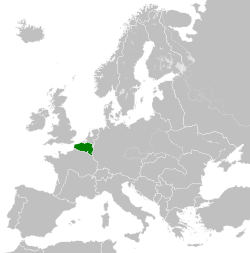Military_Administration_in_Belgium_and_North_France
Military Administration in Belgium and Northern France
1940–1944 German military administration in Belgium and France
The Military Administration in Belgium and Northern France (German: Militärverwaltung in Belgien und Nordfrankreich) was an interim occupation authority established during the Second World War by Nazi Germany that included present-day Belgium and the French departments of Nord and Pas-de-Calais.[1] The administration was also responsible for governing the zone interdite, a narrow strip of territory running along the French northern and eastern borders.[2] It remained in existence until July 1944. Plans to transfer Belgium from the military administration to a civilian administration were promoted by the SS, and Hitler had been ready to do so until Autumn 1942, when he put off the plans for what was intended to be temporary but ended up being permanent until the end of German occupation.[3] The SS had suggested either Josef Terboven or Ernst Kaltenbrunner as the Reich Commissioner of the civilian administration.[4]
This article needs additional citations for verification. (August 2009) |



